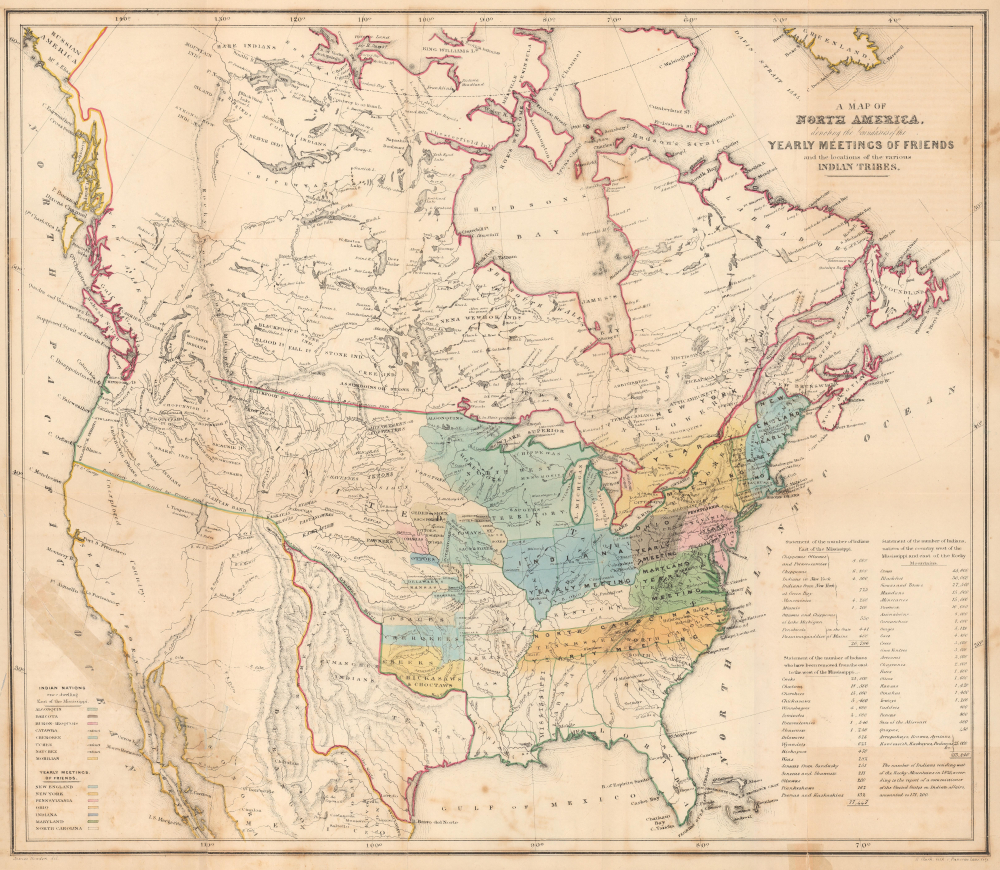This item has been sold, but you can get on the Waitlist to be notified if another example becomes available, or purchase a digital scan.
1844 Bowden Quaker Map of North America w/ American Indian Nations
NorthAmericanIndians-bowden-1844-2
Title
1844 (undated) 18.5 x 21.25 in (46.99 x 53.975 cm) 1 : 11200000
Description
A Closer Look
The map is centered on the United States and extends coast to coast. As this map predates both the Treaty of Guadeloupe-Hidalgo (1848) and the Annexation of Texas (1845), the Republic of Texas is illustrated in its fullest territorial expression, and all lands west of Texas are under Mexican sovereignty. Similarly, as the boundary of the United States with British Columbia had not yet been determined, the border here remains absent.The Trail of Tears and the Indian Removal Act
The focus of the map is on American Indian relocation related to the Indian Removal Act of 1830, which led to the Trail of Tears - a series of forced relocations of Native American peoples from their ancestral homelands in the Southeastern United States, to areas to the west of the Mississippi River designated as Indian Territory. The cartographer also identifies lands in modern-day Iowa and Kansas ceded from or sold by the Ioway, Sacs and Foxes, Sioux, Winnebago, and other tribes between 1820 and 1830. Much of the cartography in the Great Plains, where tribes are color-coded according to the reservation to which they were assigned, is derived from the 1834 Washington Hood map. To the west, as far as the Pacific, countless additional tribes are named, but there is no color coding. Some of the information here derives from the Albert Gallatin map of 1836, but the present map is far more detailed, identifying many more American Indian nations.American Indian Census
In the lower right corner, there is an American Indian population census divided both regionally and by tribe. Tables indicate the number of American Indians living east of the Mississippi River (26,796), American Indians removed from the east to West of the Mississippi (77,447), and American Indians indigenous to the region west of the Mississippi and East of the Rocky Mountains (213,240). An additional table in the lower left expounds upon the map's color coding of Indian regions and identifies the Catawba, Uchee, and Natchez as 'extinct.'Republic of Texas
The map exhibits the full claims of the short-lived Republic of Texas one year before Annexation in the United States (1845). Texas's original territorial claims extended from the Rio Grand (Rio de Norte) to the Sabine River, then from the Gulf of Mexico to the Red River as far as the 100th parallel, at which point it runs directly north to the Arkansas River, which it follows to its source in the Rocky Mountains. Although the Republic of Texas claimed extensive territory, it never fully controlled the extensive claims extending into modern-day New Mexico, or those lands between the Nueces and the Rio Grande Rivers. Nonetheless, when Texas joined the United States, these claims were honored and were one of the factors that led to the Mexican-American War (1846 - 1848). Maps illustrating the Republic of Texas are rare, as it only existed for a short 10-year period. Moreover, when maps do illustrate the Republic, their political sympathies are always evident, as few mapmaking nations officially recognized the Republic of Texas's full claims.Upper California Unexplored
South of the 1819 Adams-Onís Treaty or Transcontinental Treaty Line, in what was then Mexico, the Great Salt Lake is identified as Timpanagos and described as 'doubtful'. The territory to the west remains 'Unexplored.' In this same area, the speculative Rio de S. Bueneventuro is also identified.Publication History and Census
This map was issued in London to accompany Edward Marsh's Some Account of the Conduct of the Religious Society of Friends Towards the Indian Tribes in the Settlement of the Colonies of East and West Jersey and Pennsylvania. It was drawn by James Bowden and engraved by B. Clark. Today, this map is uncommon on the market and often under-appreciated.CartographerS
James Bowden (1811 – March 1887) was a British historian and author connected to the Society of Friends, or Quakers. Bowden was born in Liskeard, Cornwall, England and died in Stroud, Gloucestershire, England. Most of his work is associated with the Quakers, including a History of the Society of Friends in America. More by this mapmaker...
H. Clark (fl. c. 1840 - 1850) was an English lithographer active in London during the middle part of the 19th century. Clark's address was 9 Pancras Lane, London. He may have been associated with the Quakers or the Society of Friends. Learn More...

